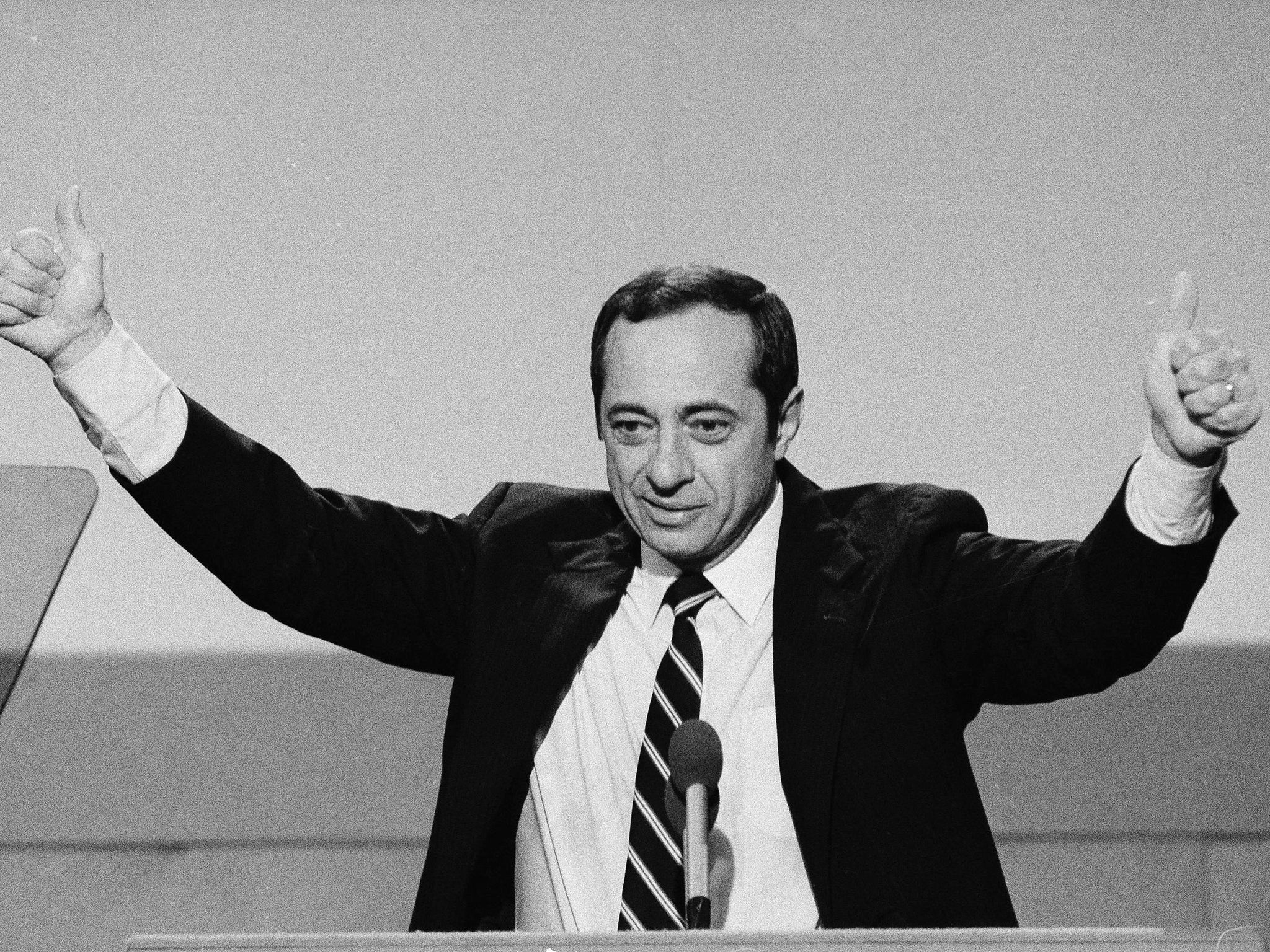Mario Cuomo: Popular Governor of New York known for his steadfast liberal values and dynamic, charismatic speech-making

Mario Cuomo was Governor of New York for three terms, from 1983 to 1994.
A charismatic figure and powerful orator, he fought against injustice, sought to eliminate the disparities between rich and poor and lived true to the American Dream. “The beauty of America is that I don’t have to deny my past to affirm my present. No one does,” he once wrote. “We can love this nation like a parent and still embrace our ancestral home like cherished grandparents.”
Cuomo was born in 1932 in Queens, New York, one of four children of Andrea Cuomo and Immaculata Cuomo, Catholic Italian immigrants who ran a small grocery store. He spoke later of his parents as “the magnificent immigrant couple who came here with nothing but aspirations and a willingness to work hard”.
He studied law at St John’s University and graduated in 1956. He came to politics by chance, after being asked in 1972 by the New York Mayor, John Lindsay, to help with a dispute about the construction of public housing. After unsuccessfully running for Lieutenant-Governor in 1974 and Mayor of New York City in 1977, he was elected Lieutenant-Governor the following year.
Cuomo was elected as Governor in 1982 and held the position for 12 years. He used his term in office to increase spending on education and social welfare. Although a life-long Catholic and personally against abortion, Cuomo was pro-choice and steadfastly opposed to the death penalty.
He was a gifted public speaker who used his words to powerful effect. At the Democratic National Convention in 1984 he gave what became known as his “Tale of Two Cities” speech, a landmark in his career. When President Ronald Reagan had spoken only a few weeks earlier of his vision of America as a “shining city on a hill”, Cuomo retorted, “A shining city is perhaps all the President sees from the portico of the White House and the veranda of his ranch... But there’s another city; there’s another part to the shining city; the part where some people can’t pay their mortgages, and most young people can’t afford one; where students can’t afford the education they need, and middle-class parents watch the dreams they hold for their children evaporate.”
In the lead up to the 1992 presidential election Cuomo was touted as a strong potential candidate for the Democrats. His stock response to questions on the subject was, “I have no plans and no plans to make plans”, while hinting at other times that he might consider running. His indecision led to him being dubbed the “Hamlet on the Hudson”: to run or not to run?
His rousing speeches had already made Cuomo better known among Democrats than Bill Clinton, the eventual nomination winner, who went on to become President. But the race was taking place in the shadow of the 1991 Gulf War, which had left George H W Bush with an approval rating of 89 per cent. Perhaps it was this that made Cuomo decide against putting himself forward? In the event, he chose to debate and resolve a local budget matter rather than fly to New Hampshire to file his nomination as the Democrat candidate. In retrospect, it is intriguing to reflect on what might have happened had he run for President, and won.
During his bids for re-election as Governor in 1986 and 1990, Cuomo set records for popularity, gaining both the highest percentage of the vote and the highest victory margin of any second or third term candidate in New York State history. In 1990 he trounced his Republican opponent, gaining 53 per cent of the vote against Pierre Rinfret, who polled just 21 per cent. However, in elections for a fourth term, during the “Republican Revolution” of 1994, he was defeated by George Pataki, and decided to retire from politics.
In his book Why Lincoln Matters: Today More Than Ever (2004) he draws on a figure who had been important to him throughout his political life. Asked about the significance of his choice of subject he replied, “My favorite thought about Abraham Lincoln is he believed in two things: loving one another and working together to make this world better.”
His son, Andrew Cuomo, has followed in his father’s footsteps as Governor of New York State, beginning a second term as Governor on 1 January. In his inauguration speech he said, “He couldn’t be here physically today, my father. But my father is in this room. He is in the heart and mind of every person who is here... his inspiration and his legacy and his experience is what has brought this state to this point.” Mario Cuomo had earlier gone through the speech with his son and joked about how it was “good, especially for a second-termer”. He died a few hours later of heart failure, surrounded by his family.
Barack Obama said in tribute to Cuomo, “He rose to be chief executive of the state he loved, a determined champion of progressive values, and an unflinching voice for tolerance, inclusiveness, fairness, dignity, and opportunity. His own story taught him that as Americans, we are bound together as one people, and our country’s success rests on the success of all of us, not just a fortunate few.”
Mario Matthew Cuomo, lawyer and politician: born Queens, New York 15 June 1932; married 1954 Matilda Raffa (three daughters, two sons); died Manhattan, New York 1 January 2015.
Join our commenting forum
Join thought-provoking conversations, follow other Independent readers and see their replies
Comments